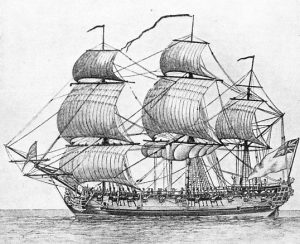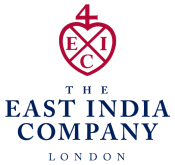London 1778
Location unknown


The London was an East Indiaman of 723 Tons. She was built in Perry’s yard, Blackwell and launched on 30th December 1771. This is the same Yard HMS Venerable was built 10 years later. She had 3 decks and a length of 137ft and breadth of 35 ft. her first voyage was from 1771 to 1773 captained by John Webb. and from 1776 to her final voyage in 1778 she was captained by Daniel Webb. Initally she was owned by John Wilkinson but was sold to her Captain John Webb in 1777.
Whilst under escort by the navy, in the English cahannel in December 1778 she was hit by HMS Russel who had just tacked, and subsiquently sank off berry head in South Devon.
The Russel was badly damaged in the incident and John Parker Rodinson (Fourth Lieutenent) who was in charge of the watch was blamed. Captain Drake who was in charge of HMS Russel was sued for damages of £50,000 by the East India Company. The ajacent sketch is of an Eastindiaman of the time similar to the “Hawswell” also features on this site.
The London was a Full Rigged Ship and had 28 32 pounders on the Gundec and 28 18 pounders on the Upper deck. She also had 14 x 9 pounders on the quater deck and 4 x 9 pounders on the Focsle.
The following is an extract from a letter to the Admiralty :
“Letter from Captain of HMS Russell dated 29th December, 1778 [Source: TNA: ADM 1/1707] HMS Russell at St Helens Sir Please to acquaint the Right Hon Lords Commissioners of the Admiralty that on Monday, 28th instant, the wind moderate and water smooth, Vice Admiral Lord Shultham and the fleet being about four or five miles to windward, I directed the Lieutenant of the watch to tack the ship as soon as he could. (but take care not to go near any of the convoy, the same directions were given to the Master) in order to get more immediately into our station at the same time observing that some of the ships of Commodore Rowley’s division, of which His Majesty’s ship under my command was, had already done the same. Soon after the ship was about and before her sails were trimmed the London belonging to the East India Company came on board us on the weather bow and received so much damage that very soon after she was clear of us, she made the signal of distress, which was also made by the Russell, and I sent an officer and three boats on board immediately to learn his situation and send them every assistance in my powers. Several of the King’s ships had by this time reached very near the London Indiaman and sent her their boats to assist in saving the people as she appeared to be sinking gradually forward and at length went down. I hope the greatest part of her crew are saved, eighteen of whom, are on board the Russell and many others, different ships of the fleet. The Russell has received much damage, and her bowsprit could not be secured at sea of which I acquainted Vice Admiral Lord Shultham by letter by the Resource frigate which his Lordship sent in consequence of the signal in which letter I requested his Lordship’s directions for my proceeding. I have since used my best endeavours to rejoin the Admiral but not being able to do it from the Admiral being so far to the windward, that I never could get sight of him from the accident to 10 pm, at which time I judged it best for His Majesty’s service to bear up to Spithead in order to get her defects repaired as soon as possible and to give their Lordships the earliest account of the disaster. I am sir etc Francis Samuel Drake Report by the Master of HMS Russell, Mr James Humphry, 28th December, 1778 At 10 am Mr John Parker Robinson, Fourth Lieutenant, having charge of the watch ordered the hands to be summoned up and everything ready to go about, myself upon deck the same time and had received orders from Capt Drake to, mind, there was no ships astern which I very earnestly attended to and saw none within a mile of us, but one, which was upon our larboard quarter, near half a mile distant standing after us. The Admiral was at this time four or five miles to windward. The ship was hove in stays the main tack being on board. Stayed very quick but the weather maintack getting foul of the guns could not get the main foreyard forward so soon as could be wished. The ship fell broad off that brought the wind abaft the beam or upon the quarter. The before mentioned ship was now right ahead, close by the wind and keeping his stretch. We then put over the helm hard a weather in order to wear under his stern, and had the other ship kept his luff I am of opinion would have weathered the Russell one cable length of more, but unfortunately they put their helm aweather likewise and both ships came together. “